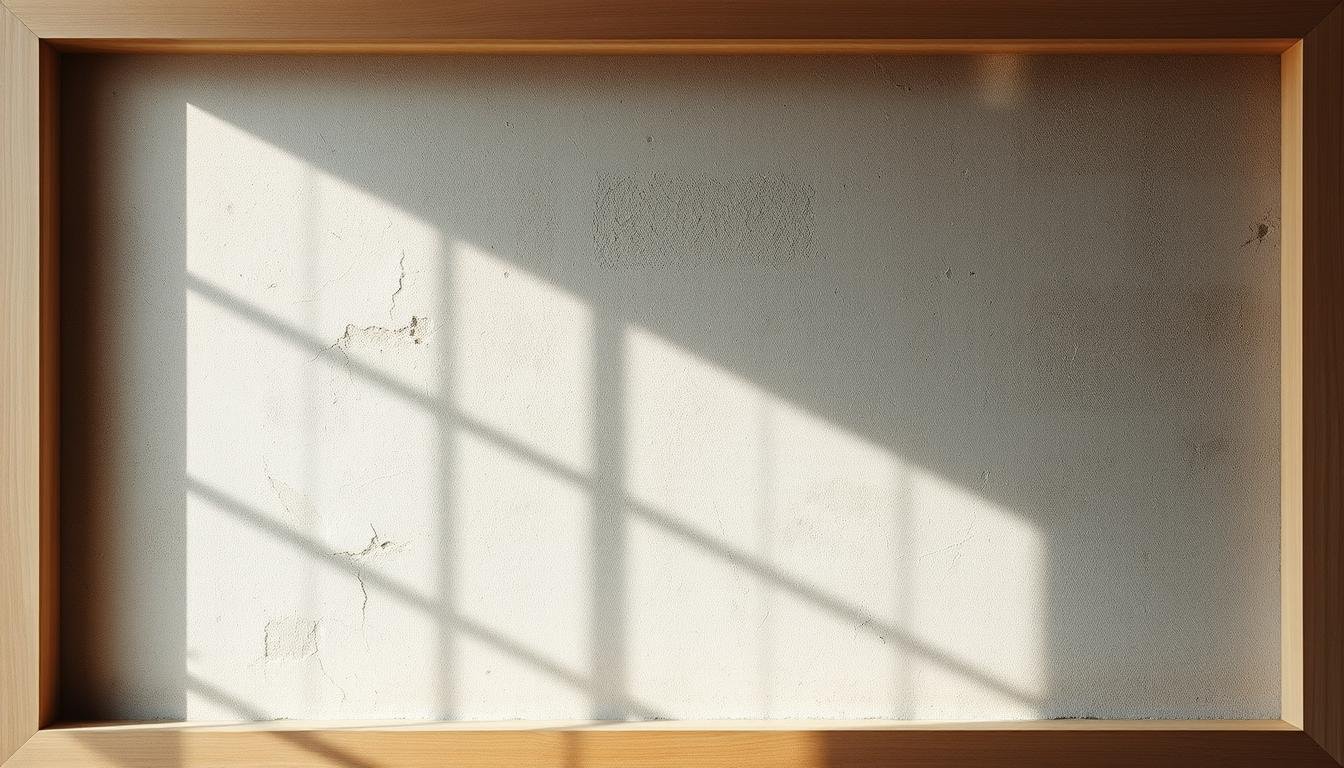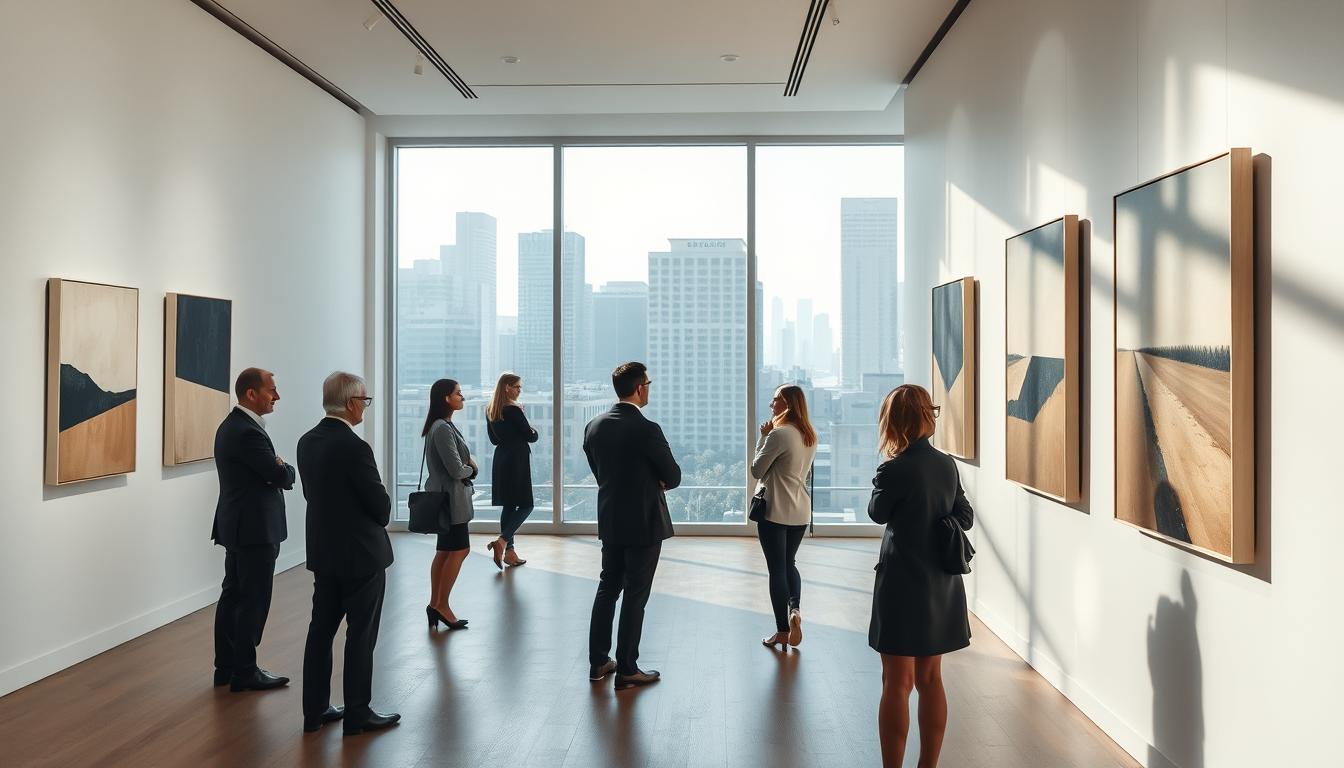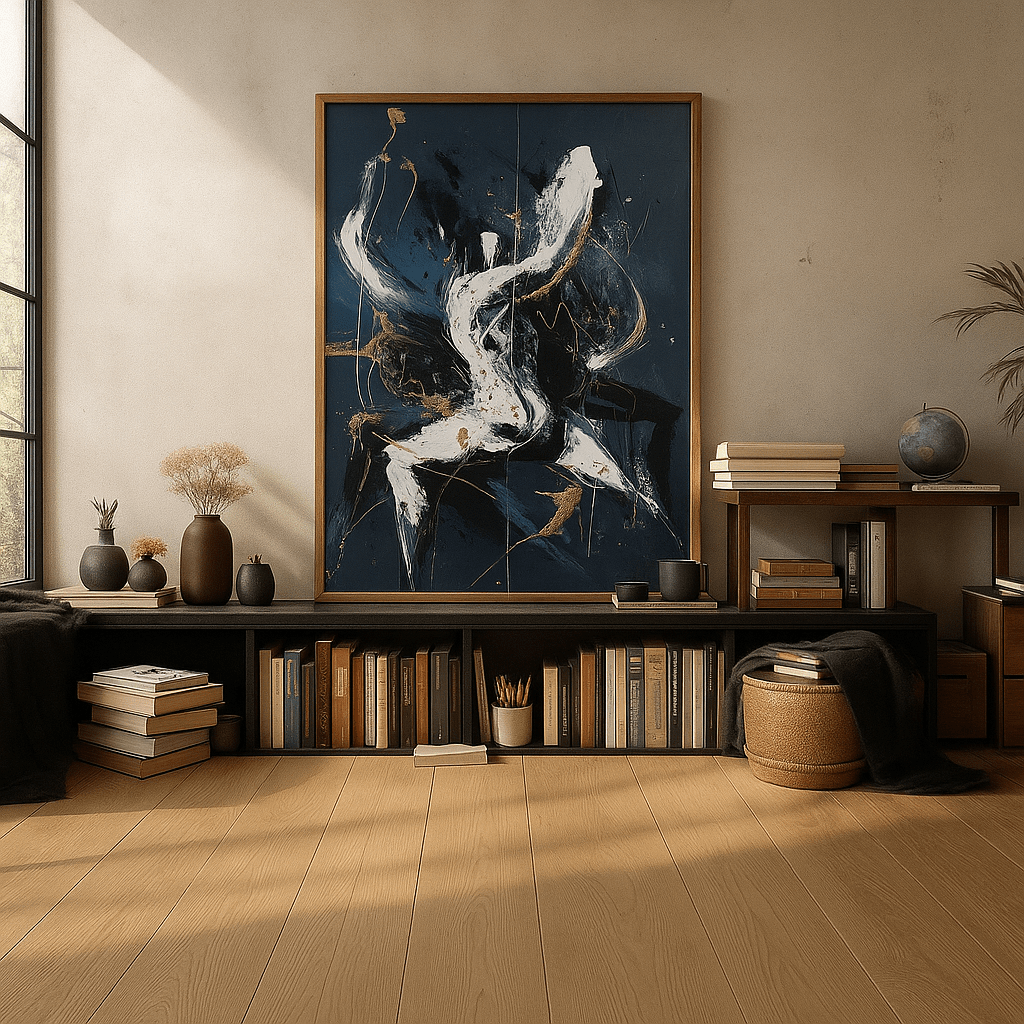Can a single, imperfect piece calm a busy room and shift the way you see everyday surfaces?
Wabi sabi is a quiet Japanese aesthetic and philosophy that finds beauty in imperfection and impermanence. It favors simple forms, natural materials, and surfaces that show age. In interiors, this approach invites restraint, warmth, and a lived-in luxury that feels honest rather than flashy.
Consider Chiara Rossetti’s Original Painting — Wabi-Sabi Black/Gray. Its black/gray palette, tactile texture, and subtle asymmetry make it a hero piece for living rooms, bedrooms, or quiet workspaces. The handcrafted finish reads as both modern and timeless.
This short guide answers the central question about wabi sabi wall art, explains how textures, patina, and muted tones create depth, and points to materials—wood, clay, paper, fibers—that ground a room in nature.

Key Takeaways
- Wabi sabi values simplicity, humility, and the passage of time.
- Texture, asymmetry, and patina express this aesthetic in modern pieces.
- Natural materials connect interiors to the world outside.
- Chiara Rossetti’s black/gray painting is a strong example of refined restraint.
- Choose one anchored piece to set tone and invite calm presence.
What is Wabi-Sabi wall art?
A quiet aesthetic, wabi sabi art celebrates marks, wear, and the simple honesty of handcrafted surfaces.
Definition: This branch of wabi sabi art treats imperfections and irregularities as part of a piece’s beauty, not flaws to hide. The result helps a room feel calm and genuine.
Core sense: tranquility, humility, and the passage of time
The aesthetic centers on simplicity, asymmetry, and the visible traces of making. Natural materials—wood, clay, paper, and fibers—create tactile surfaces where patina and wear add character over time.
Wabi-sabi encourages a gentle shift in how you see objects: subtle marks, hand-applied texture, and irregular edges become points of interest rather than distractions.
- Palette: earthy neutrals, weathered grays, muted greens, soft blues.
- Approach: fewer pieces, more negative space, quiet composition.
- Intent: thoughtful restraint—not carelessness—so each piece feels composed and humble.
For a modern example, Chiara Rossetti’s black/gray minimalist textured abstract balances refined restraint and hand-worked surfaces. One meaningful piece like this will lower visual noise and invite a more mindful daily experience.
The philosophy behind wabi-sabi art and its Japanese origins
A shift in tea culture during the 14th–16th centuries gave rise to a humble visual language still seen today. Zen monks and tea masters moved away from ornate imports and toward local, handcrafted utensils. This change laid out the core principles that inform contemporary taste.

From tea ceremonies to a rustic aesthetic
Murata Shuko and the tea master Sen no Rikyu favored simple bowls and rough textures. They elevated modest objects, teaching that modest materials and careful making matter more than shine.
Zen and the embrace of transience
Zen Buddhism taught that time and change deepen meaning. Marks, patina, and faded edges suggest life lived, not failure to preserve perfection.
Kintsugi, Raku, and Hagi
Kintsugi repairs with gold to honor breaks. Raku and Hagi show rough, neutral forms that celebrate surface and feel. These practices model how imperfections add narrative and value.
Symbols, language, and a modern counterpoint
Rikyu once shook a cherry tree so a few blossoms fell—showing that slight disorder can heighten beauty.
The enso circle echoes incompleteness. Read wabi as “less is more” and sabi as “attentive melancholy.” Together they form a guiding philosophy that contrasts with mass-produced perfection and favors handcrafted materials and unique surfaces.
- Tea ceremonies shifted taste toward modesty and nature.
- Kintsugi and pottery traditions inform how we welcome traces of life.
- Adopting these ideas in wall art invites calmer rooms and slower looking.
For an authentic yet modern piece that follows this lineage, consider Chiara Rossetti’s minimalist textured black/gray painting as a refined contemporary answer. Learn more about the broader history at the history of wabi-sabi.
Key features of wabi-sabi wall art: colors, materials, textures, and forms
Start with a simple palette that feels like a quiet walk through a weathered landscape.
Color palette: Earthy neutrals and weathered grays form a calm base. Add a single muted green or a subtle blue to give depth without loud contrast.
Natural materials: Wood, clay, handmade paper, and natural fibers lend tactile warmth. These materials age with grace and show gentle variation that factory-made pieces rarely offer.

Texture and technique
Layered paint, mineral washes, and plaster-like finishes create patina that suggests an aging process. Hand-brushed strokes, restrained palette-knife work, or collage with handmade papers keep surfaces intimate and human.
Forms and composition: Favor minimalist, irregular shapes that leave breathing room. Incomplete edges and asymmetry invite quiet attention rather than visual overload.
- Use cohesive tones and negative space to balance rough surfaces.
- Introduce one muted green plane against weathered gray to guide the eye.
- Embrace patina, but fix flaking or unsafe substrates before hanging.
Practical note: A minimalist textured black/gray piece, like Chiara Rossetti’s, exemplifies layered surfaces and weathered gray tones. It can act as a sophisticated anchor in luxury modern interiors while keeping authenticity intact. For more examples, learn more about wabi sabi pieces.
Incorporating wabi-sabi into your modern interior design (United States, present)
Start your room plan by choosing one meaningful object that shapes color, scale, and mood. In living rooms and bedrooms, hang the textured black/gray piece above a low sofa, credenza, or bed so natural light can skim its surface.
Rooms and use-cases: Use smaller works in meditation corners and workspaces to keep focus. In larger spaces, a single statement piece reduces clutter and raises the sense of beauty.
Furniture and elements
Choose raw woods, woven linens, and ceramics that age well. Let furniture patina; a worn leather seat or a timeworn stool adds warmth and history.
Light, atmosphere, and safety
Maximize natural light with sheer curtains or mirrors to highlight subtle texture. Embrace the aging process gently—repair anything that risks decay and use stable mounts for long-term display.
- Keep objects intentional: one handmade vase or a chipped tea bowl creates story without clutter.
- Palette: soft beiges, muted greens, weathered blues, and earth tones tie pieces to a calm color palette.
- Styling Rossetti’s painting: allow negative space; pair with raw wood, linen upholstery, and ceramic accents for a refined, lived-in luxury.
Selecting and styling wabi-sabi artwork for your space
Start by letting scale and calm guide your choices rather than filling every inch of a room.
Scale, placement, and negative space on the wall
Measure the main furniture piece before you buy. For an 84-inch sofa, choose a single artwork about 50–70% of that width so the composition breathes. For a bed, pick a painting that anchors the headboard with a comfortable margin on each side.
Hang the center of the painting at roughly 57–60 inches from the floor. Adjust slightly if seating is low so the texture reads while sitting. Leave generous empty space around the piece; negative space is an active part of the composition.
Pairing with objects that tell a story
Choose a small vignette to echo the painting’s surfaces: one handmade tea bowl, a short stack of worn books, or a single branch in a clay vase. Keep objects low and few so they do not compete with the painting’s forms.
Favor natural materials and simple techniques—layered pigment, subtle relief, and hand-worked fiber. These tactile cues support the wabi and sabi sensibility and help the room feel lived-in but refined.
- Let the painting’s palette guide textiles and accessories.
- Prefer slightly irregular forms and gentle asymmetry for a relaxed feel.
- Use grazed light to reveal micro-textures; keep nearby objects minimal.
Practical note: If you choose Chiara Rossetti’s Original Painting — Wabi-Sabi Black/Gray, pick a size that reads from the main seating area, hang it at eye level, and pair it with a single ceramic piece to keep the composition serene.
Conclusion
A calm, textured piece can become the quiet center of a modern room.
Core principles rest on simplicity, asymmetry, natural materials, and respect for the marks of time. These principles help a home feel grounded and humane rather than staged.
Choose muted palettes, hand-worked surfaces, and generous negative space so daily life breathes around each object. Let sunlight reveal texture and keep finishes safe and stable as they age.
Wabi sabi offers a way back to small, honest beauty. For a refined, modern expression, consider Chiara Rossetti’s Original Painting — Wabi-Sabi Black/Gray, a timeless textured focal point that pairs easily with wood, linen, and ceramics.
Notice the curve of a bowl, the shift of tone over months, and the quiet story each piece brings to your world.
Enhance Your Space with Unique Modern Masterpieces by Chiara Rossetti
Are you inspired by the innovative mediums and conceptual depth highlighted in our exploration of contemporary art? You’re not alone! Today’s art enthusiasts are seeking cultural relevance and emotional connections in their artwork. However, finding pieces that resonate with modern themes and fit your unique style can be a challenge. That’s where we come in!
At Rossetti Art, we specialize in canvas prints, original paintings, and modern sculptures that celebrate the spirit of now. Each piece created by Chiara Rossetti brings a personal touch that connects deeply with current social narratives—just like the modern masterpieces discussed in the article. Don’t miss out on the chance to elevate your home decor with breathtaking artwork that speaks to your values and aesthetic. Explore our collection today and find your perfect piece! Act now, and transform your space into a gallery of inspiration!
FAQ
What does wabi-sabi wall art celebrate?
It honors imperfection, impermanence, and simplicity. Pieces focus on texture, muted tones, natural materials, and the quiet beauty of aging rather than glossy perfection.
Where did the philosophy behind this style come from?
Roots trace to Japanese tea ceremony masters like Sen no Rikyu and ideas in Zen Buddhism. Traditions such as kintsugi, raku, and hagi pottery embody repair, modesty, and acceptance of change.
Which colors and materials work best?
Earthy neutrals, weathered grays, soft blues, and muted greens pair well with wood, clay, handmade paper, and natural fibers. These choices emphasize organic texture and subtle patina.
How does texture contribute to the aesthetic?
Texture becomes the focal point. Rough clay, layered paint, fabric slubs, and visible brushwork invite tactile appreciation and signal honest handcraft.
Can this style fit modern American interiors?
Absolutely. Use pieces in living rooms, bedrooms, meditation corners, and home offices. Combine raw woods, ceramics, and woven textiles with clean lines for a contemporary, lived-in feel.
How should I choose scale and placement?
Favor negative space and restraint. A single textured canvas or an irregular cluster lets the eye rest. Small groupings with breathing room read as intentional and calm.
What objects pair well with these pieces?
Tea bowls, handmade ceramics, aged books, and simple botanicals complement the narrative quality. Choose items that show use and carry a story.
Is it okay to embrace wear while avoiding damage?
Yes. The goal is graceful aging, not neglect. Prevent harmful decay by controlling humidity, avoiding direct sun, and using stable display methods while allowing natural patina to develop.
How do I style a minimalist textured black or gray painting for a luxury space?
Let the painting dominate a pale, uncluttered wall. Pair it with warm wood furniture, restrained metal accents, and soft textiles to balance starkness with warmth and tactility.
Are there modern makers or movements to follow for inspiration?
Look to contemporary ceramicists, independent textile studios, and galleries that feature handmade work. Museums like the Metropolitan Museum of Art and local craft fairs often showcase pieces that reflect these principles.
How can I introduce elements gradually?
Start with one or two handcrafted objects or a single textured piece. Swap a glossy accessory for a matte, worn-looking item and add natural fibers to soften the room without a full overhaul.







Leave a comment
This site is protected by hCaptcha and the hCaptcha Privacy Policy and Terms of Service apply.